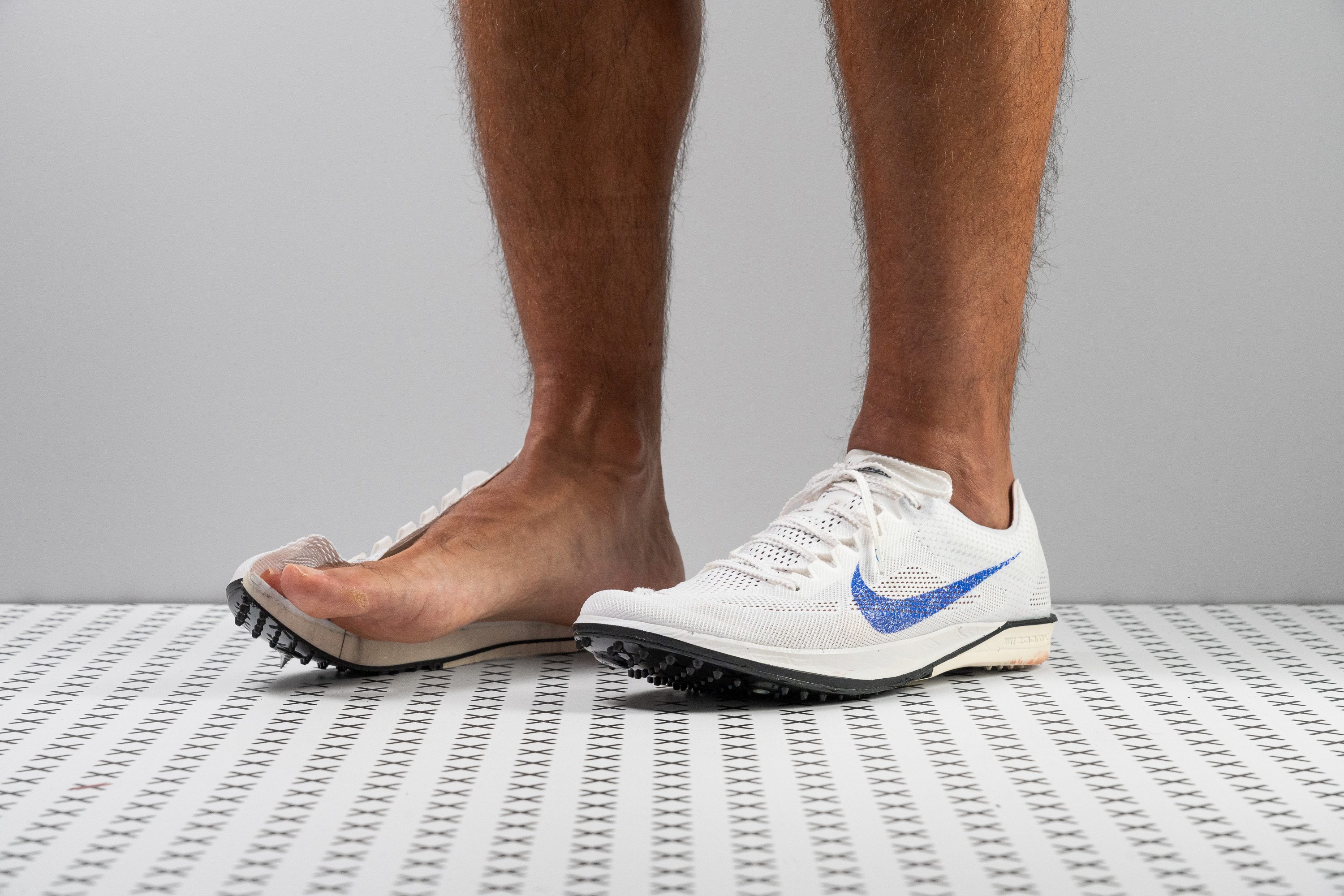Our verdict
- Top pick in best running spikes
Pros
- Ideal for long-distance track events
- Breathable upper
- Full-length Pebax plate
- Enhanced stability
- New 4-pin outsole design
- Superb fit with notched laces
- Highly responsive midsole
- Can handle 800m races too
Cons
- Upper lacks durability
- Small weight gain
- Price increase
Audience verdict
- Top 24% in running spikes
- Top 28% in Nike running spikes
- Top 16% most popular tracking shoes
Comparison
The most similar running spikes compared
+ + Add a shoe | |||||
|---|---|---|---|---|---|
| Audience score | 95 Great! | 90 Great! | 79 Decent! | 96 Superb! | |
| Price | £160 | £200 | £200 | £150 | |
| Weight lab | 5.1 oz / 145g | 4.8 oz / 135g | 4.6 oz / 129g | 4.7 oz / 133g | |
| Breathability | Breathable | Breathable | Breathable | Breathable | |
| Use | Long DistanceMid Distance | Long DistanceMid Distance | Long DistanceMid Distance | Long DistanceMid Distance | |
| Removable spikes | ✓ | ✓ | ✗ | ✓ | |
| Width / fit | Wide | Medium | Wide | Narrow | |
| Toebox width | Medium | Medium | Medium | Medium | |
| Drop lab | 0.2 mm | 0.6 mm | 4.1 mm | 2.0 mm | |
| Size | True to size | True to size | Slightly small | Slightly small | |
| Midsole softness | Balanced | Soft | Balanced | Balanced | |
| Tongue padding | Average | Thin | Thin | Average | |
| Stiffness | Moderate | Moderate | - | Flexible | |
| Torsional rigidity | Stiff | Stiff | Stiff | Stiff | |
| Heel counter stiffness | Flexible | Flexible | Flexible | Flexible | |
| Outsole thickness | Average | Thin | Average | Average | |
| Outsole hardness | - | - | - | Very soft | |
| Heel tab | None | None | None | None | |
| Heel stack lab | 19.9 mm | 19.9 mm | 19.8 mm | 19.8 mm | |
| Forefoot | 19.7 mm | 19.3 mm | 15.7 mm | 17.8 mm | |
| Insole thickness | Very thick | Thick | Thin | Average | |
| Midsole width - forefoot | Average | Average | Average | Average | |
| Midsole width - heel | Average | Very wide | Average | Average | |
| Ranking | #3 Top 24% | #8 Bottom 38% | #13 Bottom 1% | #1 Top 8% | |
| Popularity | #2 Top 16% | #3 Top 24% | #5 Top 39% | #8 Bottom 38% |
Who should buy
After our lab evaluations, we think that the Dragonfly 2 is an ideal choice for:
- Runners aiming to excel in track events from 1500m and beyond—this spike is designed to support long distances with its ZoomX cushioning.
- Athletes who find standard running spikes too restrictive; the Dragonfly 2 offers a roomier forefoot area, providing a balance of snug fit and space where it counts.
- Die-hard fans of the original Dragonfly. This update delivers a full-length plate and improved energy return, ensuring a responsive and efficient training and race experience.
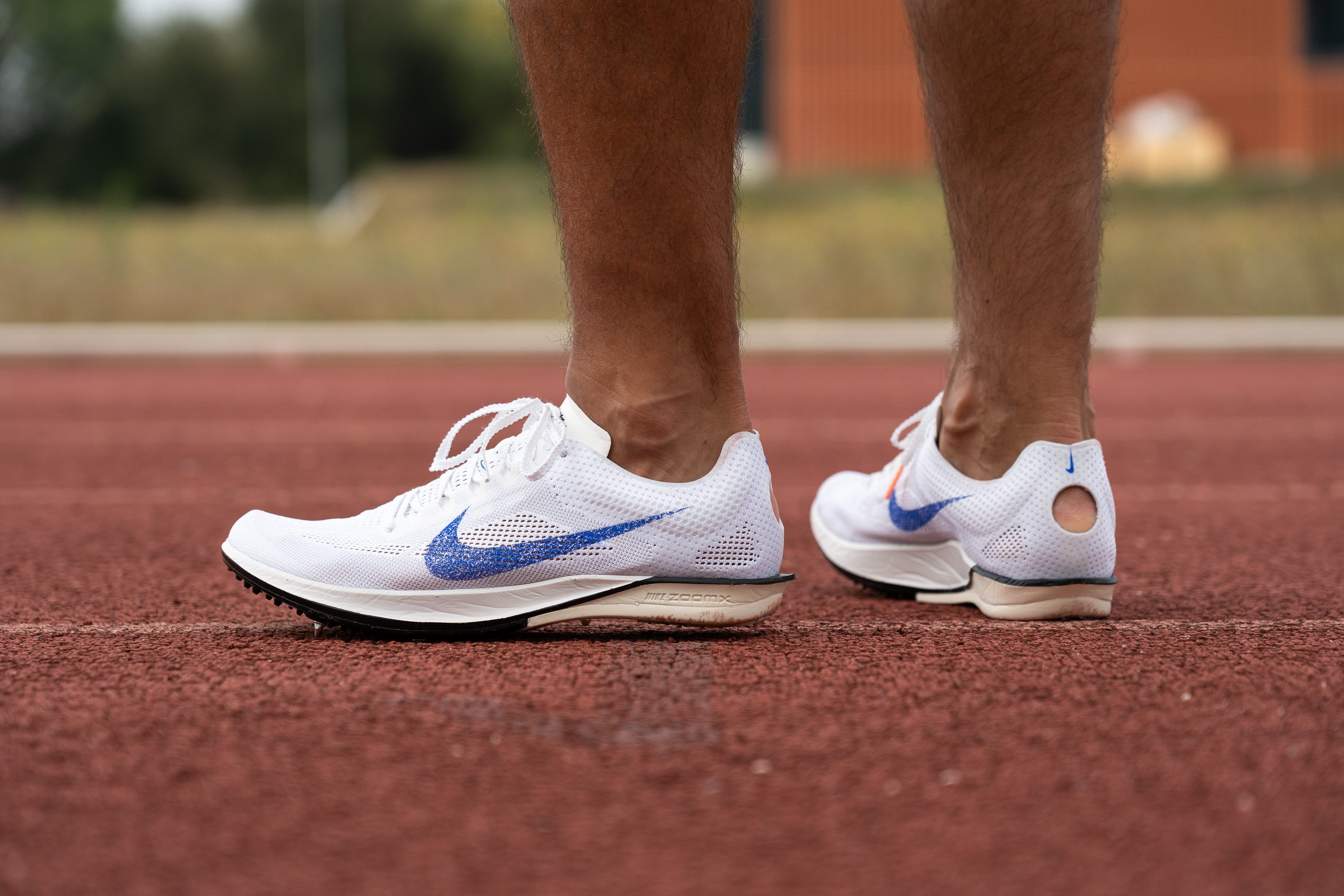
Who should NOT buy
While the Nike Dragonfly 2 could once again claim a top spot among running spikes, it's not the best fit for everyone. We've observed that runners tackling shorter distances like 800m or heavier individuals with a powerful running style may find that the Nike Air Zoom Maxfly offers superior performance, enhancing finishing times in both races and interval training sessions.
Additionally, we noted the Dragonfly 2's price has risen to £160—a £10 increase from its predecessor—which might be even more prohibitive for some. For athletes seeking a much cheaper Nike spike, we think the Zoom Rival D 10 could be the answer.
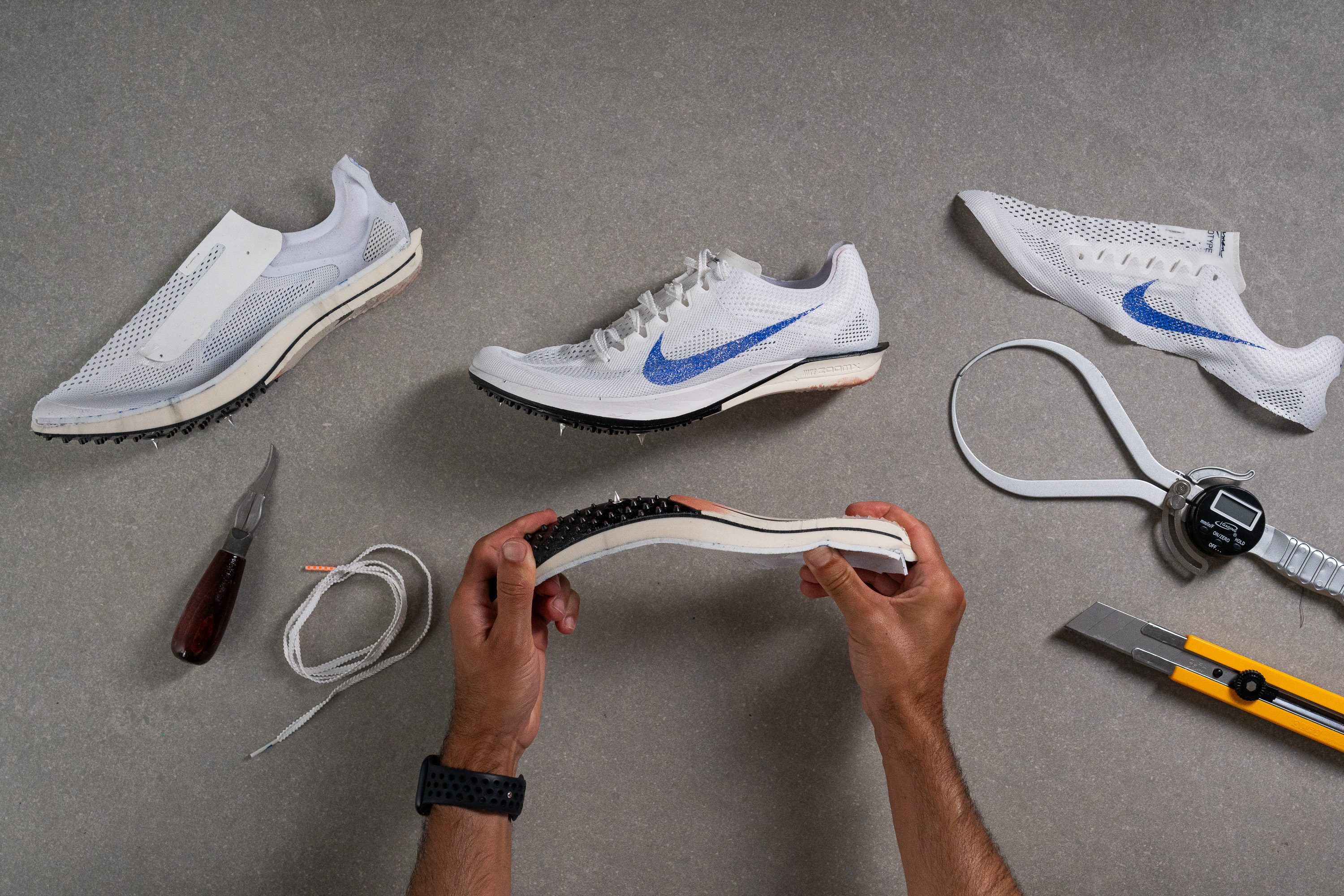
Cushioning
Heel stack
The standout feature of the Dragonfly 2 is its cushioning, crucial for long-distance spikes designed for events longer than 1500m, especially the 5K and 10K. At the end of the day, more foam underfoot means fresher legs at the end of the race.
Nike has excelled this time by pushing the limits up to World Athletics' new 20-mm stack height regulation, with the Dragonfly 2 measuring precisely 19.9 mm. This makes it fully ready for official competitions!
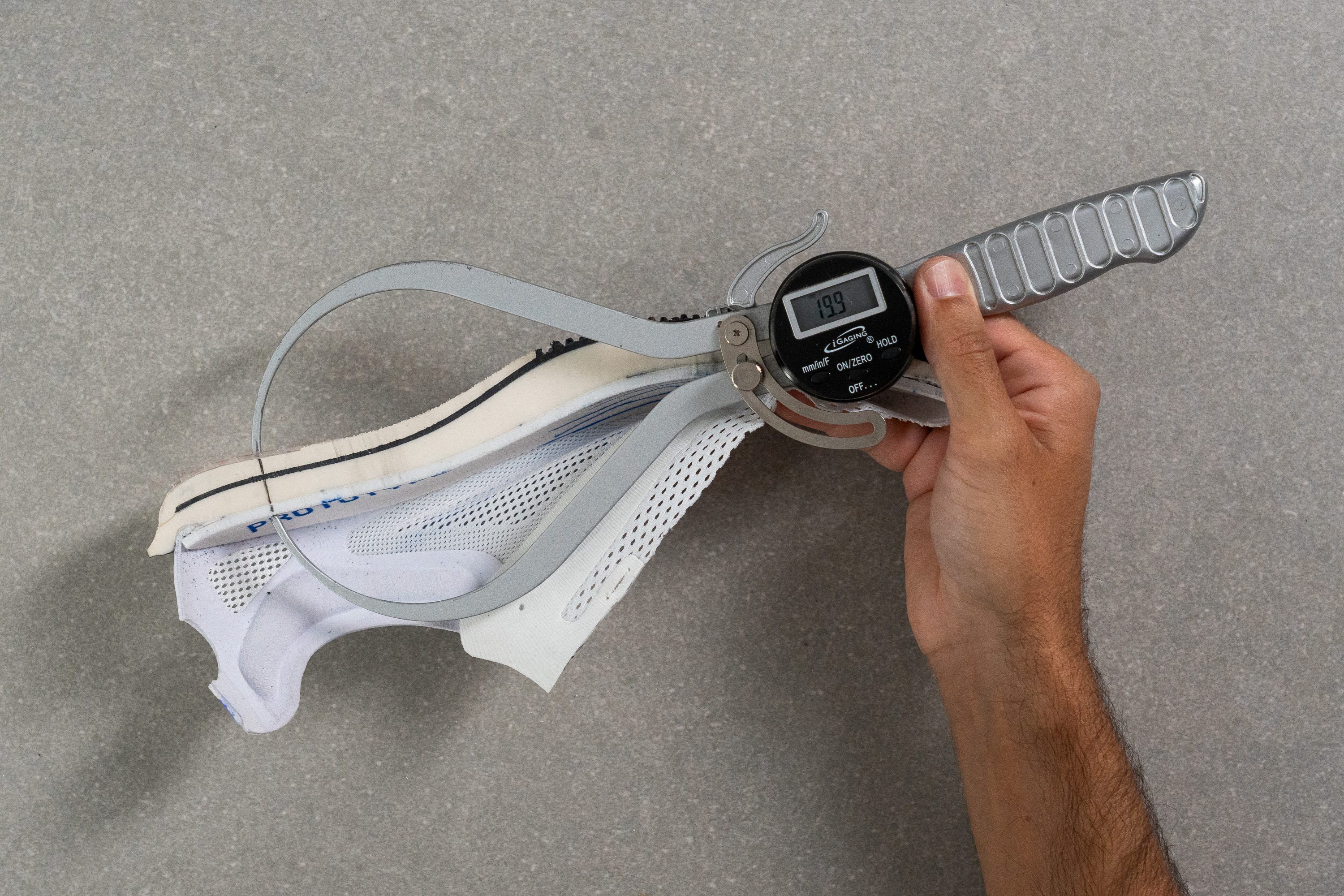
| Dragonfly 2 | 19.9 mm |
| Average | 16.0 mm |
Forefoot stack
The forefoot is also testing the limits, now reaching a height of 19.7 mm, nearing those infamous 20 mm. This marks a significant improvement over version 1, which only had a stack of 17.8 mm in this area.
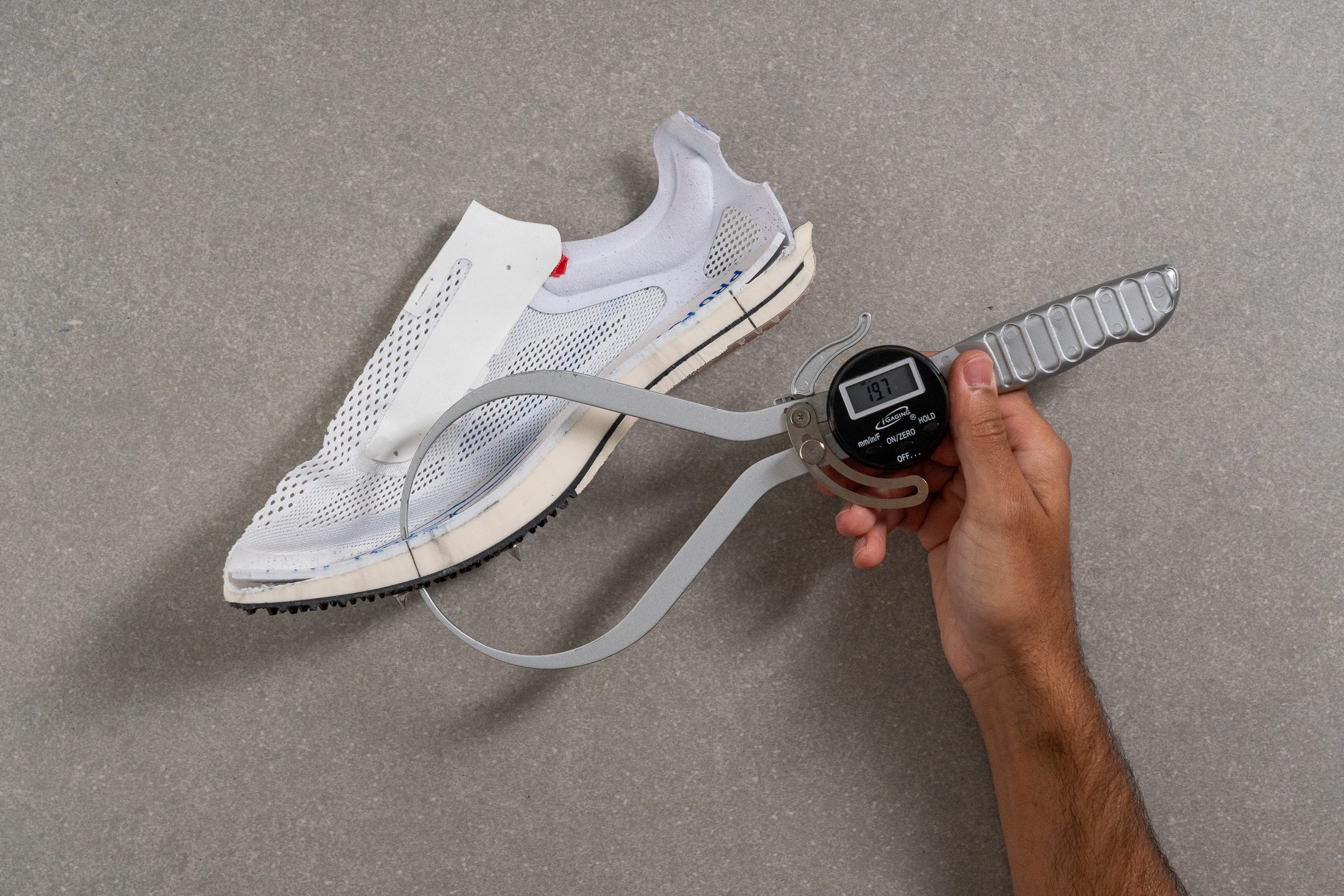
| Dragonfly 2 | 19.7 mm |
| Average | 15.3 mm |
Drop
The minimal 0.2 mm drop between the heel and toe measurements results in an almost flat design for the Dragonfly 2—a wise choice aimed at maximising the amount of ZoomX foam underfoot for those long and gruelling events in the track.
By maximising the cushioning to the 20-mm limit from heel to toe, runners benefit from the fullest cushioning permissible under current rules. And if this results in a zero-drop spike, who cares?
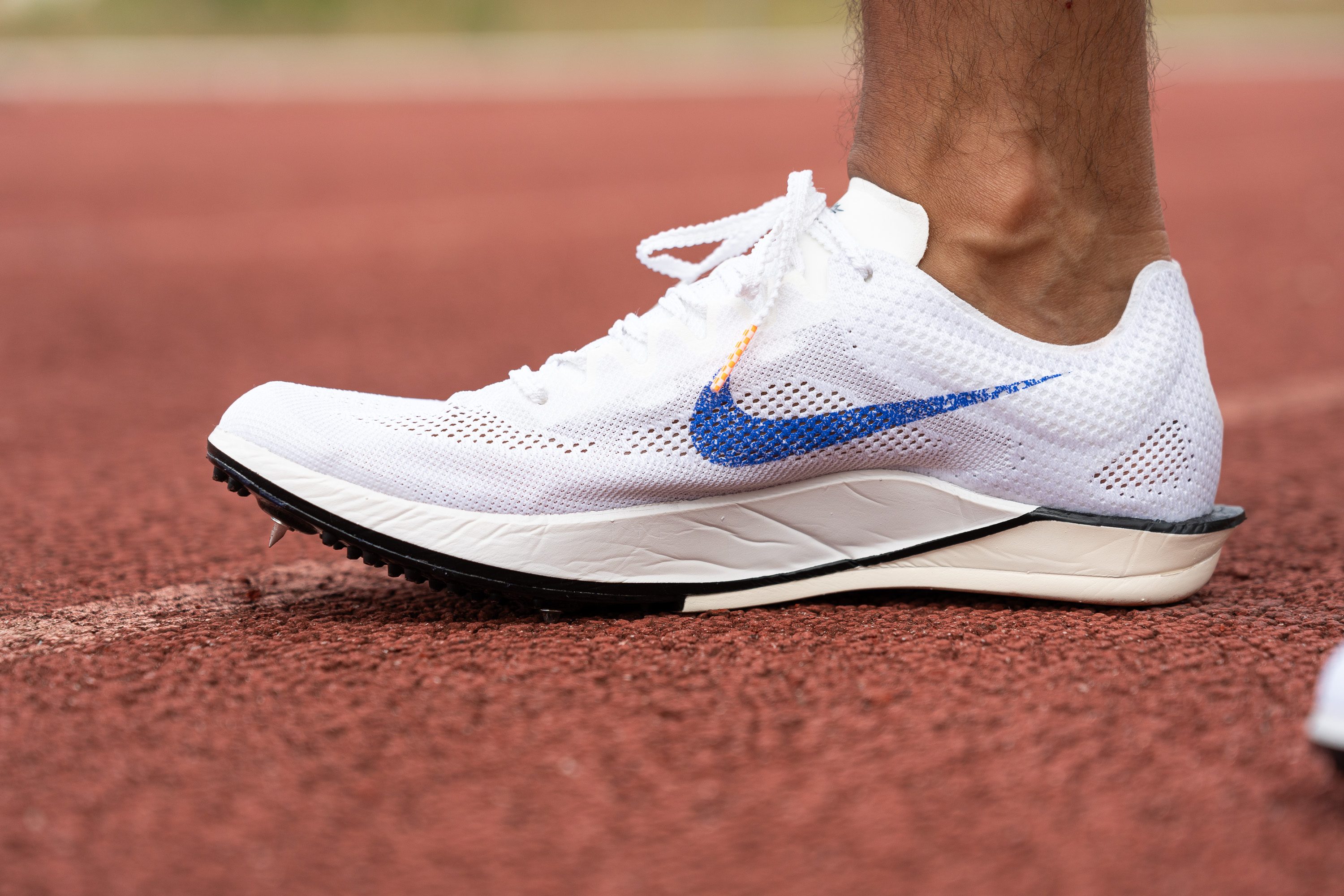
| Dragonfly 2 | 0.2 mm |
| Average | 0.7 mm |
Midsole softness
The charm of the Dragonfly 2 stems from its responsive ZoomX midsole. Although it doesn't offer the ultra-plush feel of some road shoes—registering a firmer 24.5 HA on our durometer—we're thoroughly impressed with its performance.
Given the 20 mm stack limit, opting for a cloud-like foam is a bad idea, as it would frequently bottom out and lead to a less responsive experience, especially since this edition of the Dragonfly 2 doesn’t include a stiff carbon plate.
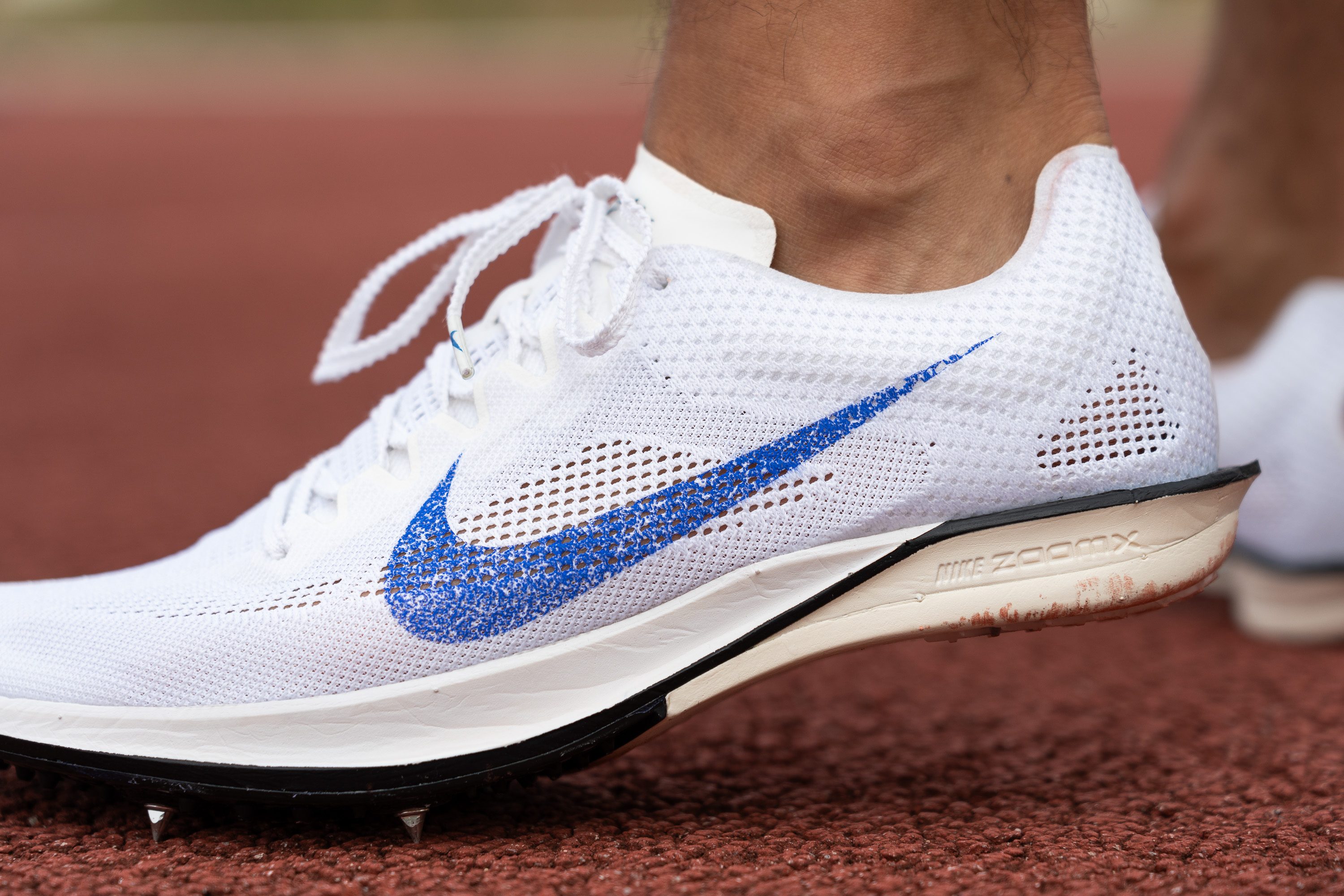
But hey, is it responsive? Undoubtedly! It boasts the same magical, bouncy ZoomX we've admired in the Alphafly and Vaporfly series, providing tremendous energy return. Most importantly, it saved our calves, helping to keep legs fresh for the critical final laps of long track races.
For proof of its effectiveness, look no further than Sifan Hassan, who clinched a bronze medal in the 10K on a Friday night using her Dragonflys, and then astonishingly won the Olympic Marathon with the Alphafly 3 just 36 hours later.
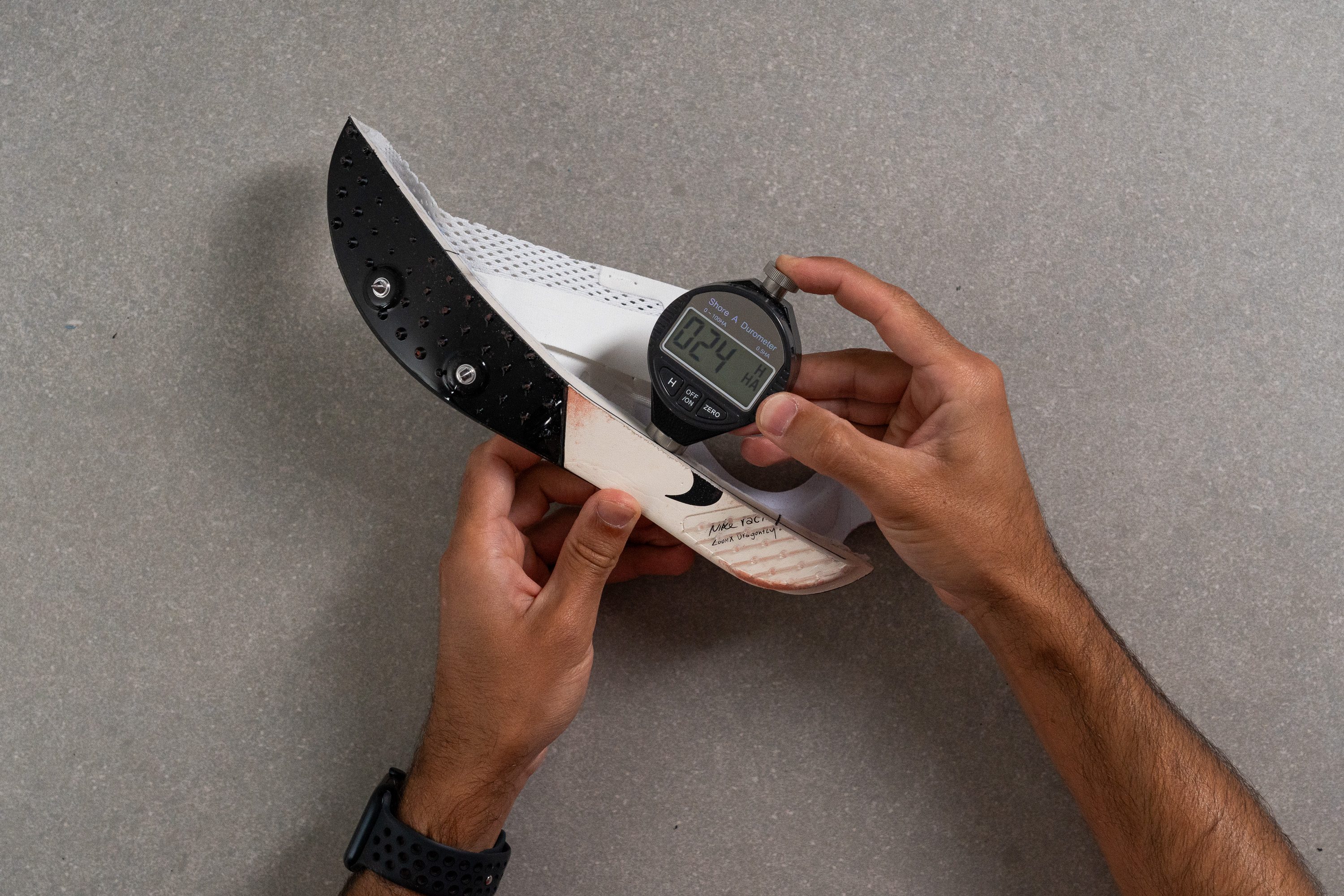
| Dragonfly 2 | 24.5 HA |
| Average | 23.8 HA |
Removable pins
The Dragonfly 2 introduces a new, streamlined 4-pin setup, a change from the original model's bulkier 6-pin configuration.
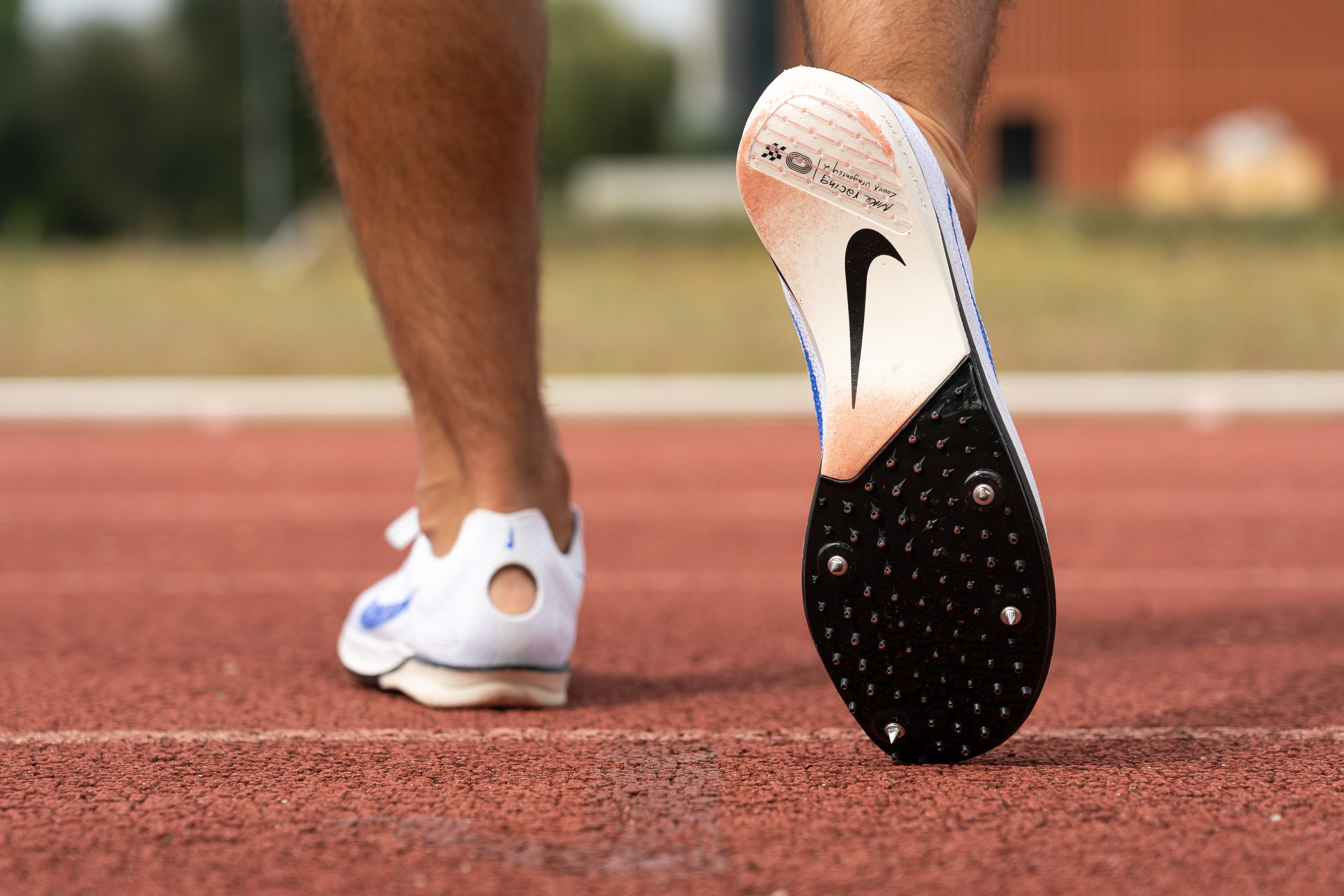
Each pin is detachable with the included tool, offering the flexibility to customise the shoe's traction to your favourite track.
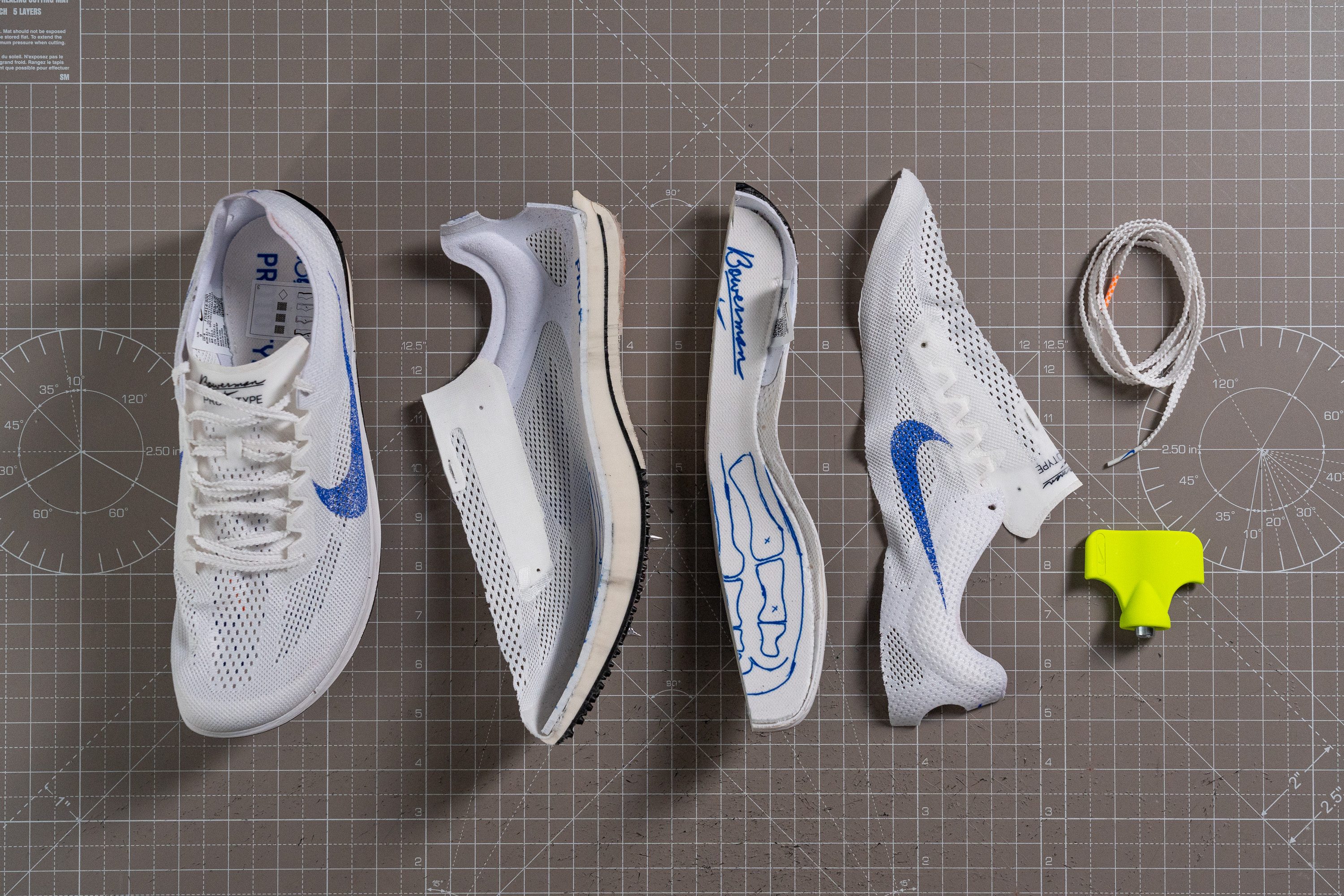
Plate
The original Dragonfly featured a full-length Pebax plate, and that doesn't change in version 2, although the plate is a bit stiffer this time. Only the Dragonfly 2 Elite features a carbon-fibre Flyplate.
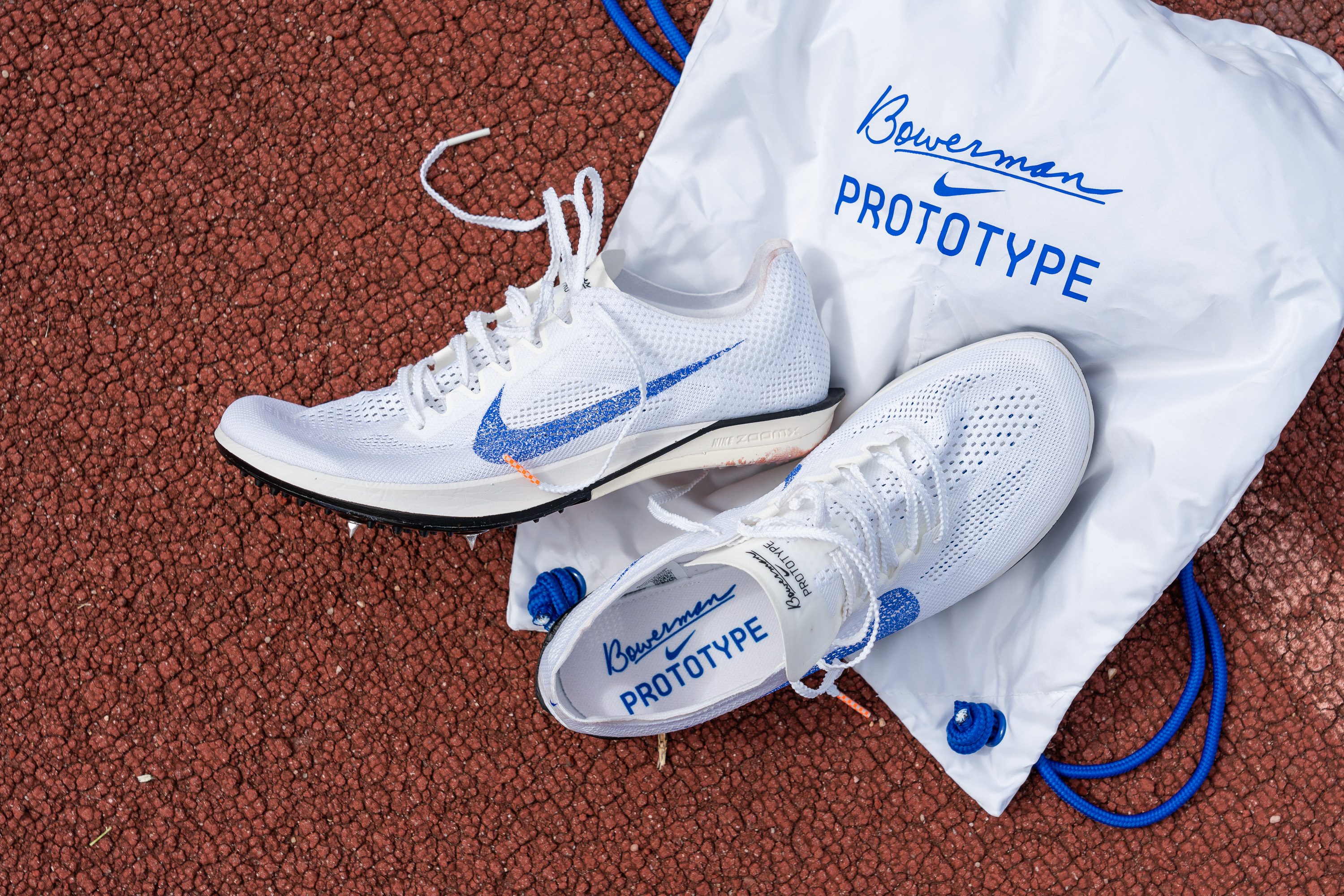
Nonetheless, as we just said, the new Pebax plate goes from the heel to the forefoot, making direct contact with the track's tartan surface—no foam in between—and it's definitely stiffer than before. How much? Let's see.
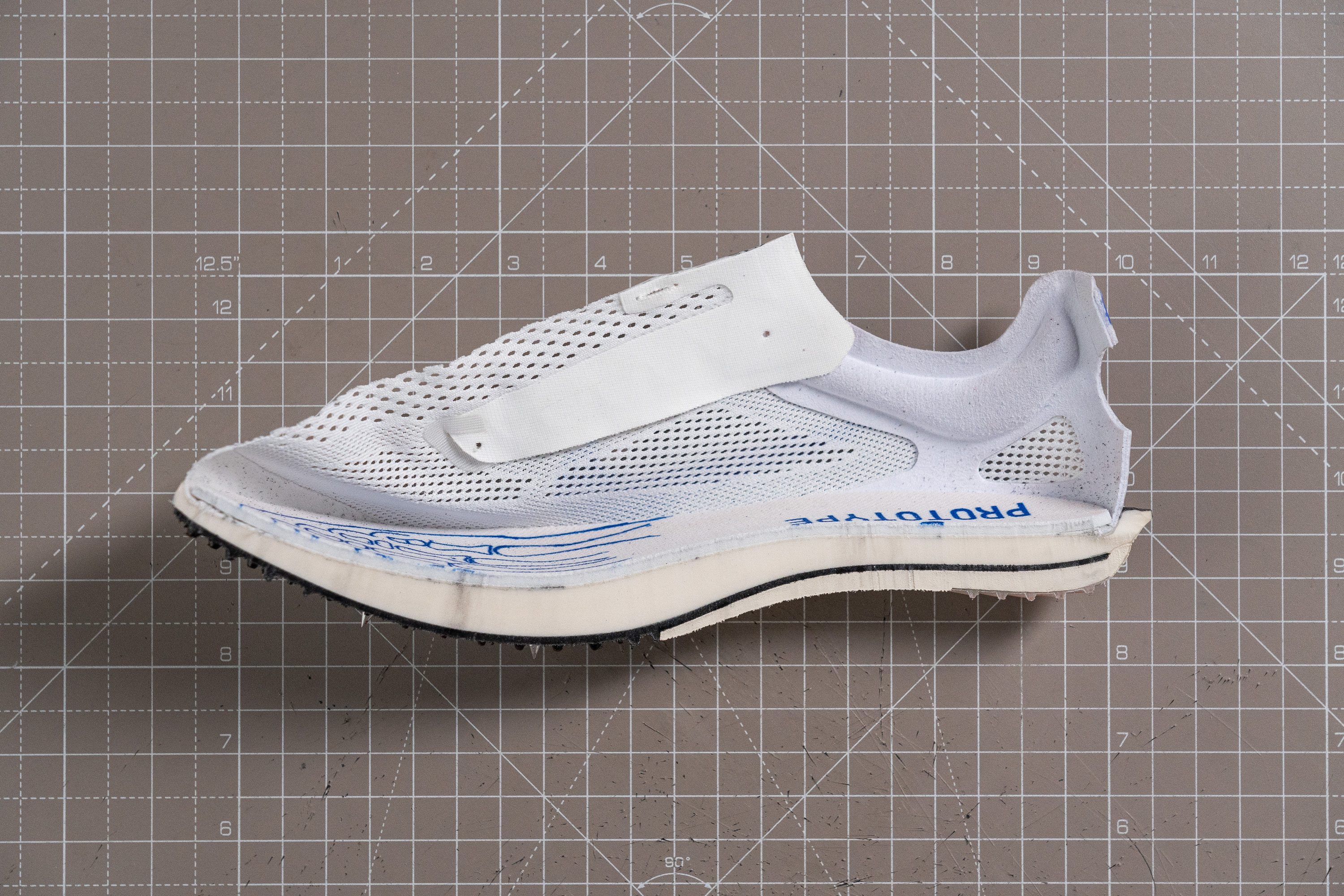
Size and fit
Size
Nike Dragonfly 2 fits true to size (64 votes).
Width / Fit
The Dragonfly 2 features what we consider a surprisingly spacious fit for a track spike, although it makes sense as it's made for long distances.
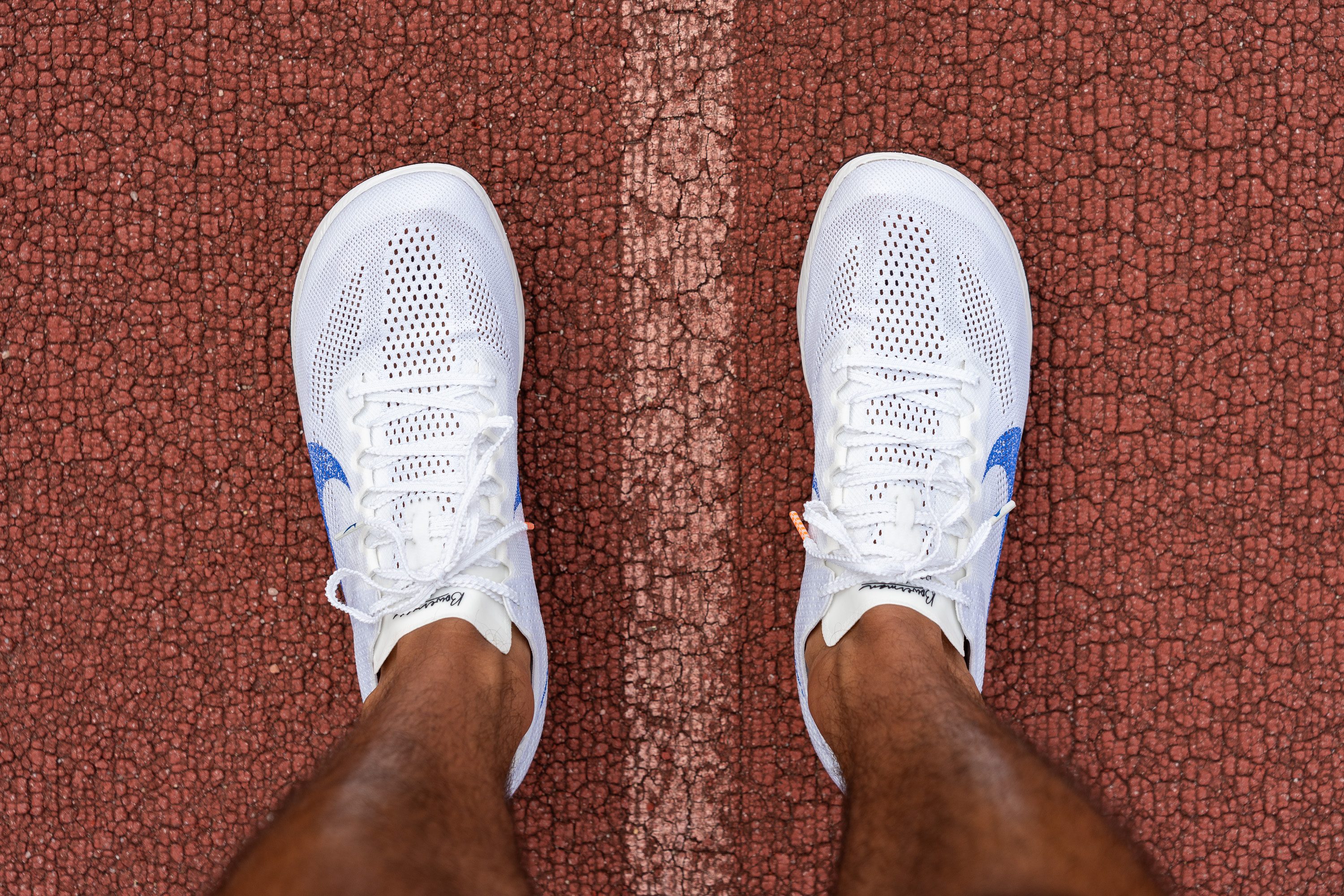
To make sure we are not mistaken, we retrieved a 1:1 replica of the shoe's interiors using proprietary gel and measured its the dimensions precisely with a digital calliper.
Indeed, the tool showed an above-average reading of 90.3 mm in the widest part! This exceeds the width of most other spikes on the market—quite notable for being a Nike!
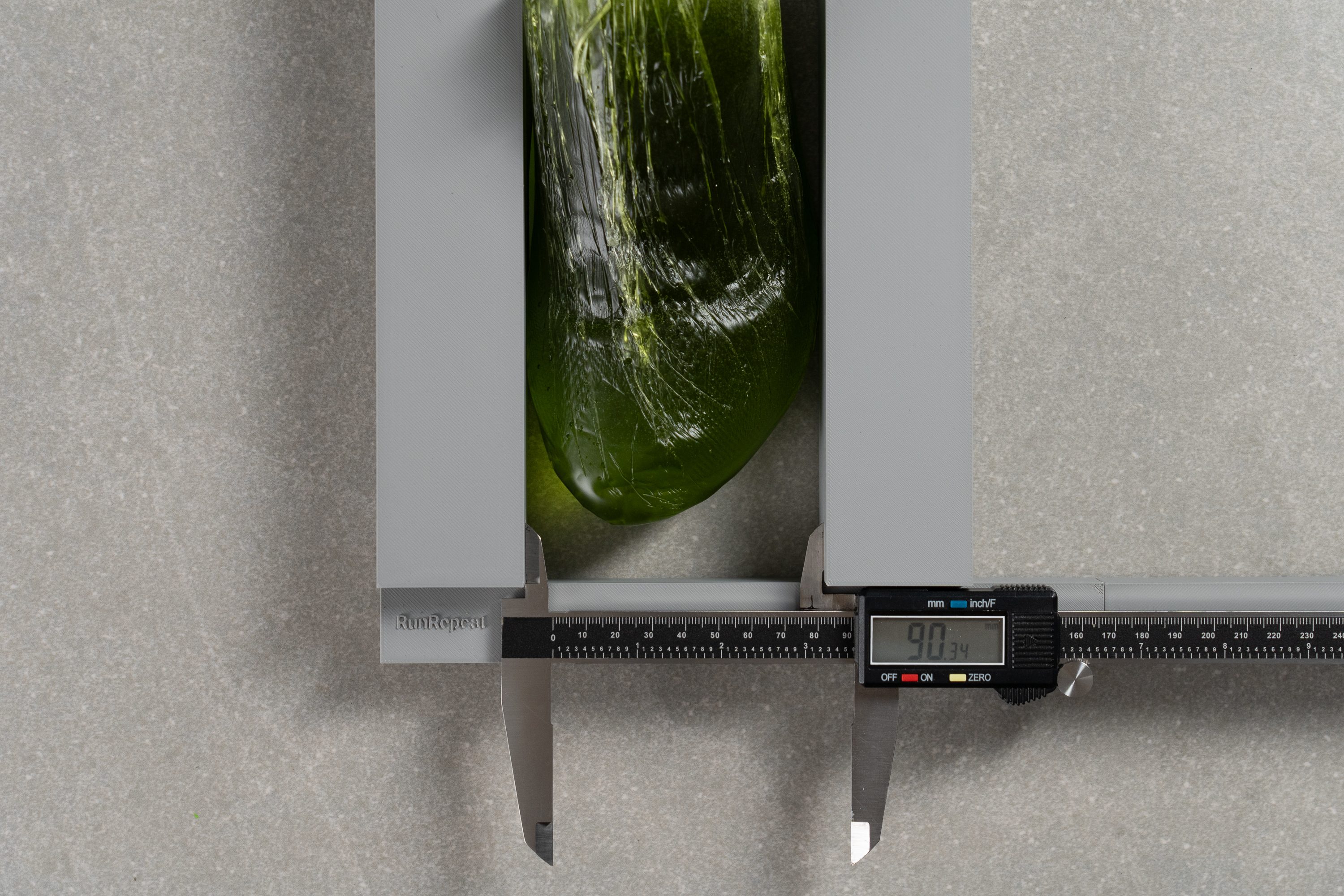
| Dragonfly 2 | 90.3 mm |
| Average | 88.4 mm |
Toebox width
The big toe area also showed a wider reading of 71.3 mm. A bit roomier than average bt as a track spike, you can still expect a fairly snug, performance-oriented fit in the Dragonfly 2.
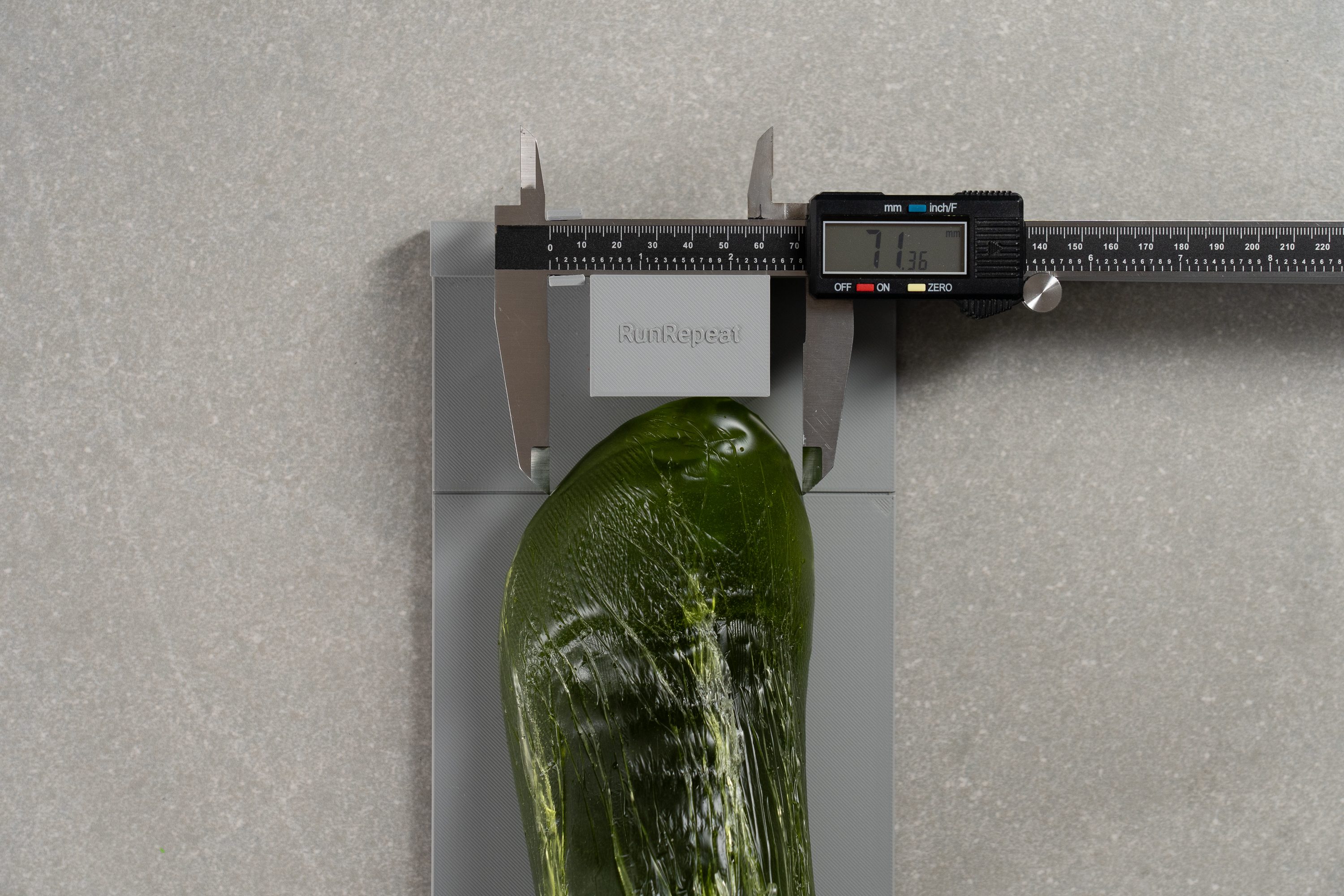
| Dragonfly 2 | 71.3 mm |
| Average | 69.0 mm |
Toebox height
This Nike silhouette also treated us to a pretty generous vertical space.
With a toebox height of 27.1 mm, it offers more wiggle room than a standard track spike.

| Dragonfly 2 | 27.1 mm |
| Average | 25.8 mm |
Flexibility / Stiffness
We conducted our standardised 30-degree test and recorded a result of 9.2N.
That’s impressively low and clearly shows the absence of a carbon plate—otherwise, the number could’ve easily tripled. It’s ideal for athletes seeking a snappy-yet-flexible ride.
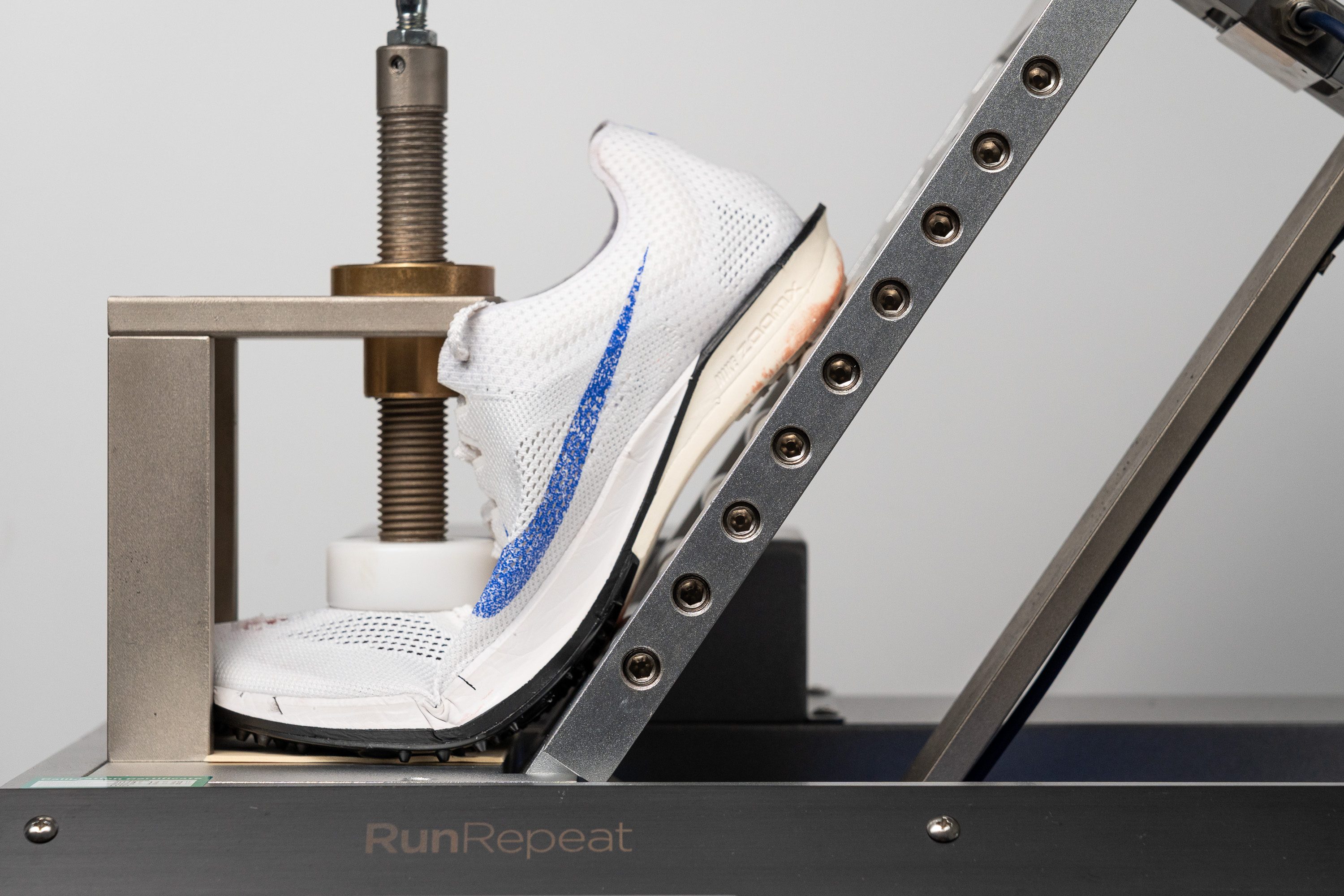
| Dragonfly 2 | 9.2N |
| Average | 13.2N |
Weight
The Dragonfly 2 remains impressively lightweight at 5.1 oz (145g), although we observed that our pair gained a bit of heft compared to the original version, which weighed in at 4.7 oz (133g) in our lab tests.
We believe this minor weight increase is likely due to the added ZoomX foam in the forefoot, which provides enhanced cushioning and energy return. Then, from our perspective, the slight increase in weight will be justified for most runners, as this is a long-distance spike.

| Dragonfly 2 | 5.1 oz (145g) |
| Average | 5.6 oz (158g) |
Breathability
When we unboxed the Dragonfly 2, we were immediately struck by the ultra-light, airy mesh of the upper—ventilation holes were everywhere!
Our smoke-pumping machine test confirmed the impressive airflow, leading us to award a perfect 5/5 for this update—an essential feature for runners who compete in 10K events without socks.
The light helped us highlight the areas with enhanced ventilation on this spike. Surprisingly, the airflow extends across the entire midfoot and includes a thinner section on each side of the heel, showcasing meticulous attention to detail.
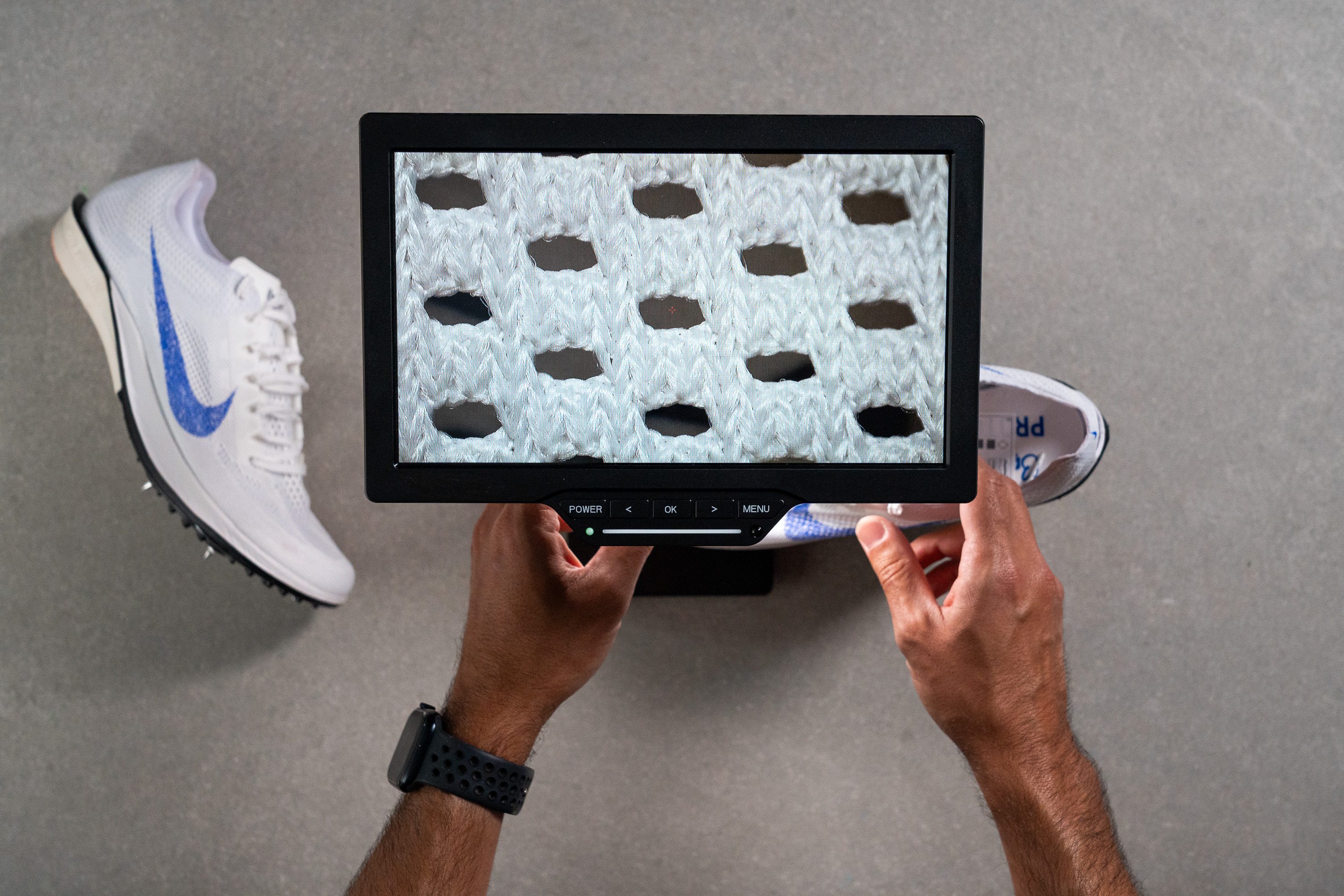
We took a closer look at those ventilation holes and absolutely loved them.
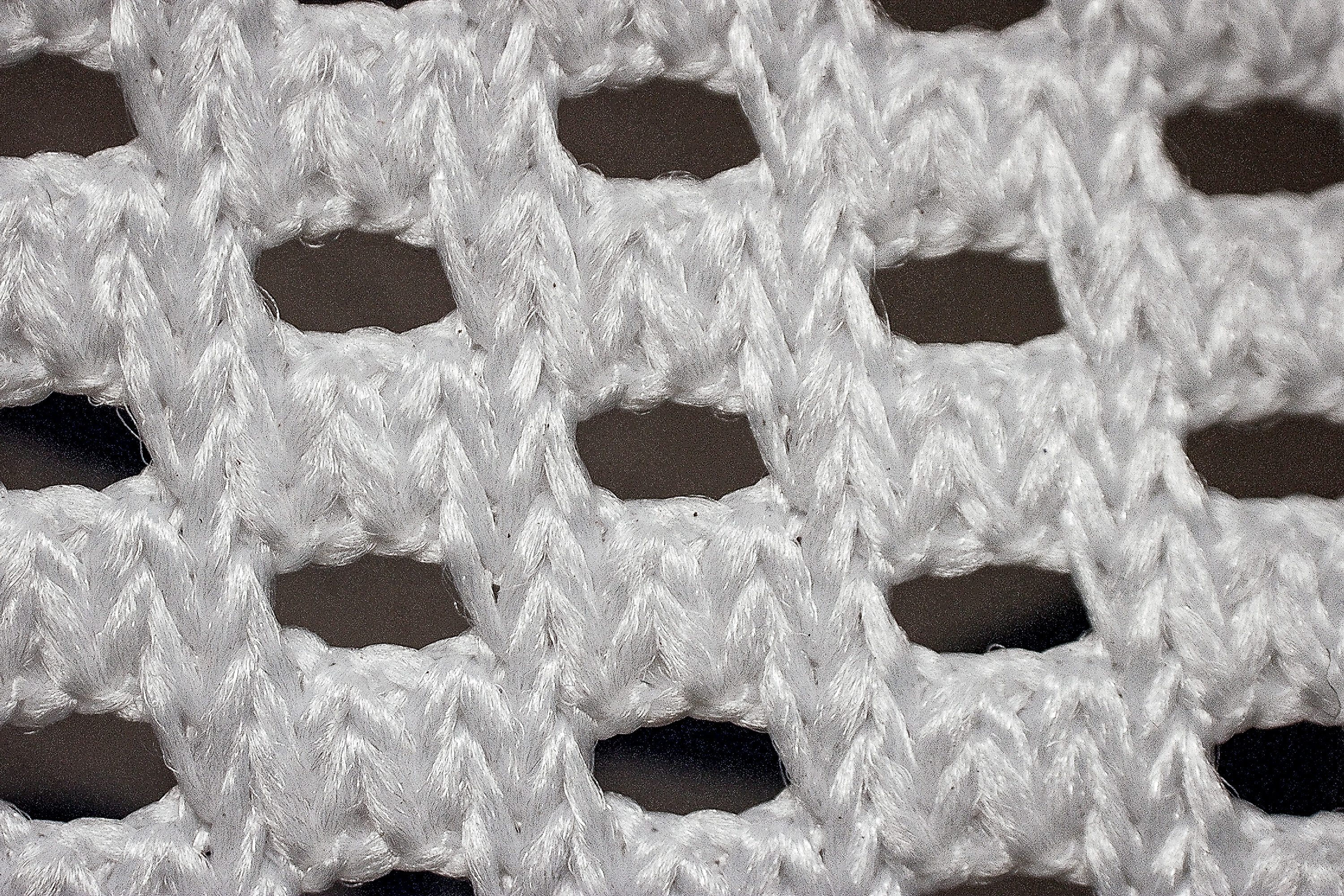
The upper is crafted from a single layer without any secondary fabric or rough spots, allowing for unimpeded air circulation.
The mesh is slightly stretchy, providing a snug fit while retaining breathability. We also discovered that, although most of the upper is minimally padded, there are strategically placed foam pads below the ankles extending to the heel, adding a touch of comfort where it's needed most.
| Dragonfly 2 | 5 |
| Average | 4.1 |
Stability
Torsional rigidity
During our hands-on torsional rigidity test, we discovered that the Dragonfly 2 demonstrated remarkable stiffness.
Despite incorporating a flexible Pebax plate, we could induce hardly any twisting. Consequently, we awarded it a max score of 5/5. This performance marks an uptick over its predecessor, which had scored 4/5.
| Dragonfly 2 | 5 |
| Average | 3.3 |
Heel counter stiffness
While the DF2 features an exceptionally stiff build, the heel counter is quite the opposite, scoring a 1 out of 5 in our evaluation. Yet, we found a good lockdown because of the large hole, which is more functional than decorative, despite appearances suggesting otherwise.
| Dragonfly 2 | 1 |
| Average | 1.7 |
Midsole width - forefoot
The original Dragonfly was the gold standard for long-distance running spikes, and it's clear that Nike opted for a conservative approach with its successor, making only minimal enhancements while preserving much of the shoe's design. Among these subtle changes are the midsole dimensions.
We measured a slight variation, finding 98.0 mm in the second version compared to 98.2 mm in the original. This difference of just 0.2 mm is negligible, roughly equivalent to the thickness of a human hair.

| Dragonfly 2 | 98.0 mm |
| Average | 95.1 mm |
Midsole width - heel
The heel is slightly wider at 62.4 mm, compared to 60.2 mm in the first version. This small difference is not particularly significant, as heel striking is less common in track workout or races.
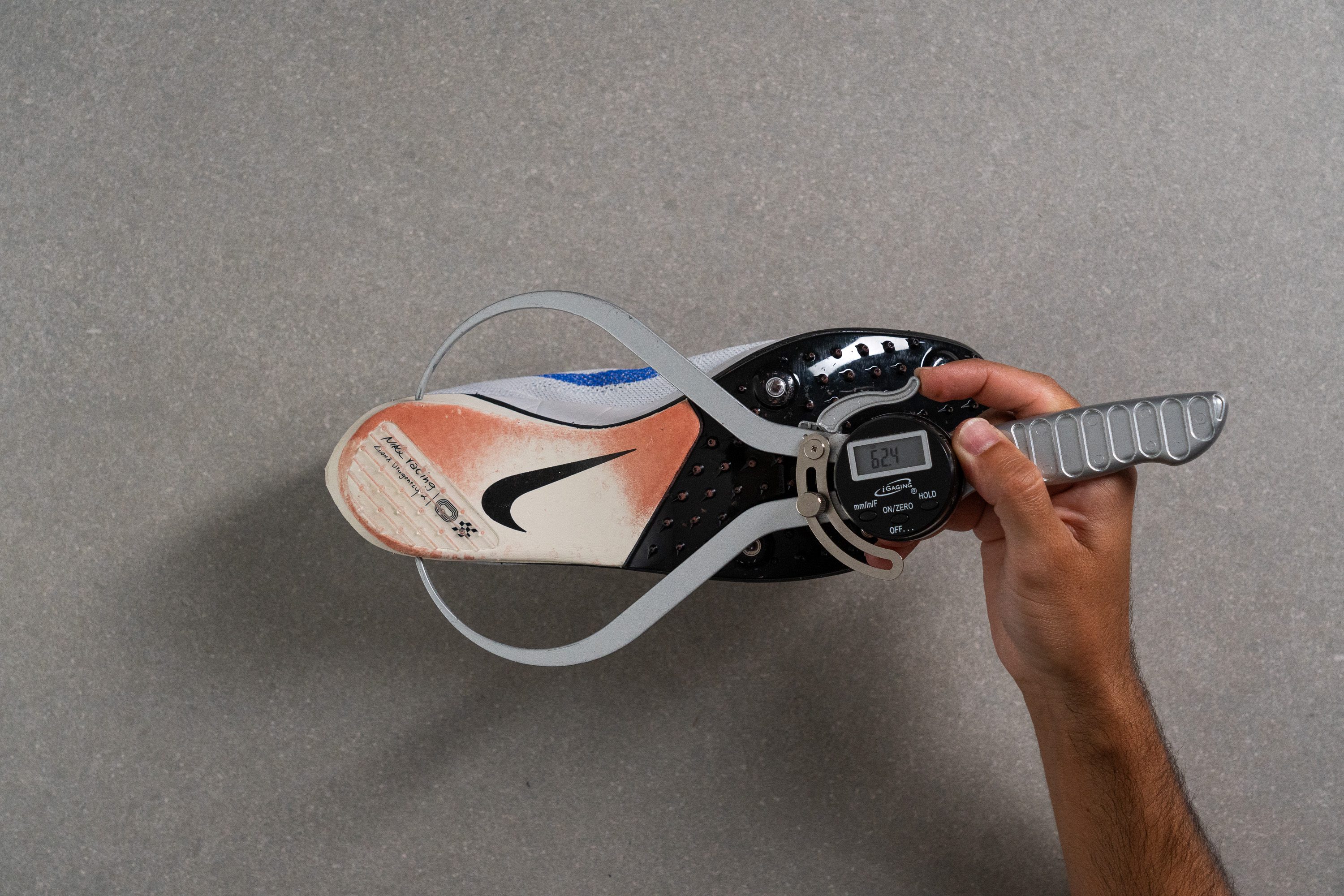
| Dragonfly 2 | 62.4 mm |
| Average | 63.0 mm |
Durability
Toebox durability
The enormous ventilation holes on the Dragonfly 2 made us sceptical about its durability.
Indeed, it scored a low 1/5, clearly not the outcome we hoped for. And other spikes like the sprint-oriented Adidas SP2 have shown that it’s possible to combine robust durability with excellent ventilation!
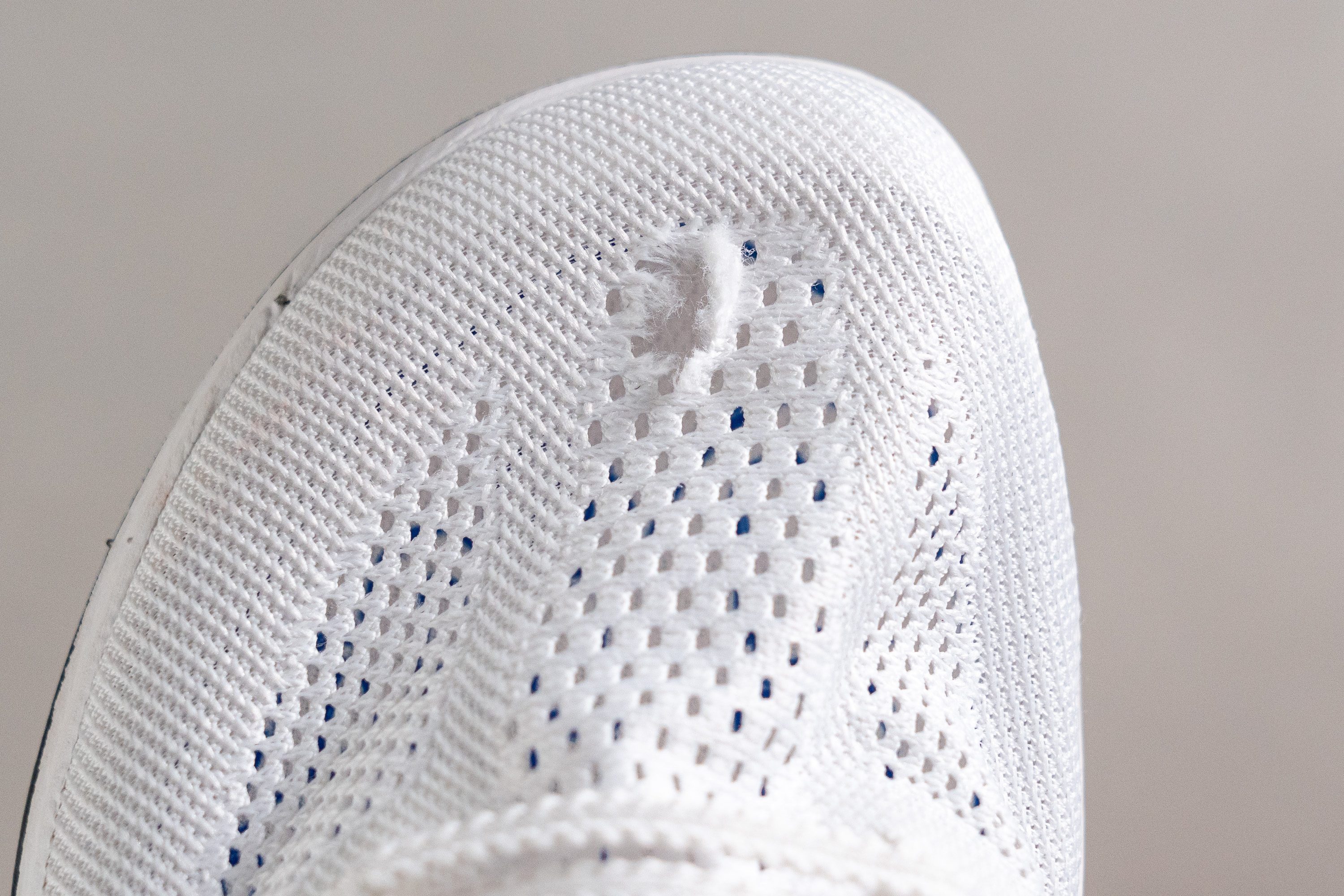
| Dragonfly 2 | 1 |
| Average | 2.4 |
Heel padding durability
Following a disappointing outcome in the initial Dremel test, we shifted our focus to evaluating the heel counter of the Dragonfly 2.
Here, we discovered a marginal improvement, scoring it a mere 2/5. Despite this slight enhancement, it's clear that there remains significant room for improvement in this area for Nike.
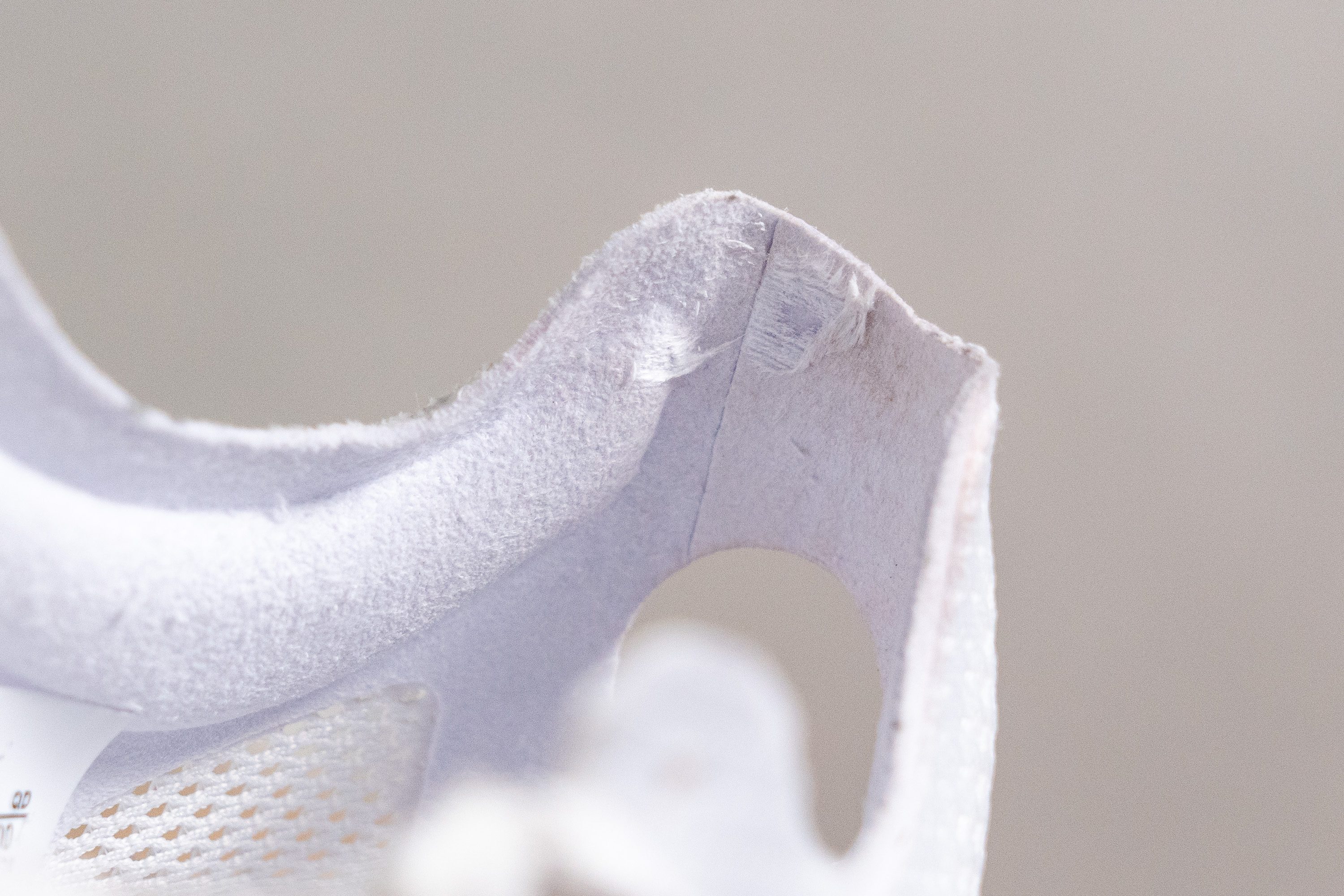
| Dragonfly 2 | 2 |
| Average | 3.6 |
Outsole thickness
We measured the Dragonfly 2 outsole at 2.6 mm, which is half a millimetre thinner than its predecessor. This reduction is a smart move, as it allows for the addition of more foam underfoot!

| Dragonfly 2 | 2.6 mm |
| Average | 2.7 mm |
Misc
Insole thickness
The insole of the DF2 is thicker than we would prefer. For us, this feels like a missed opportunity, as it unnecessarily uses up 3.7 mm of potential ZoomX foam space.
Perhaps Nike could consider slimming it down or, even better, using a ZoomX footbed—a change we're quite excited to see!
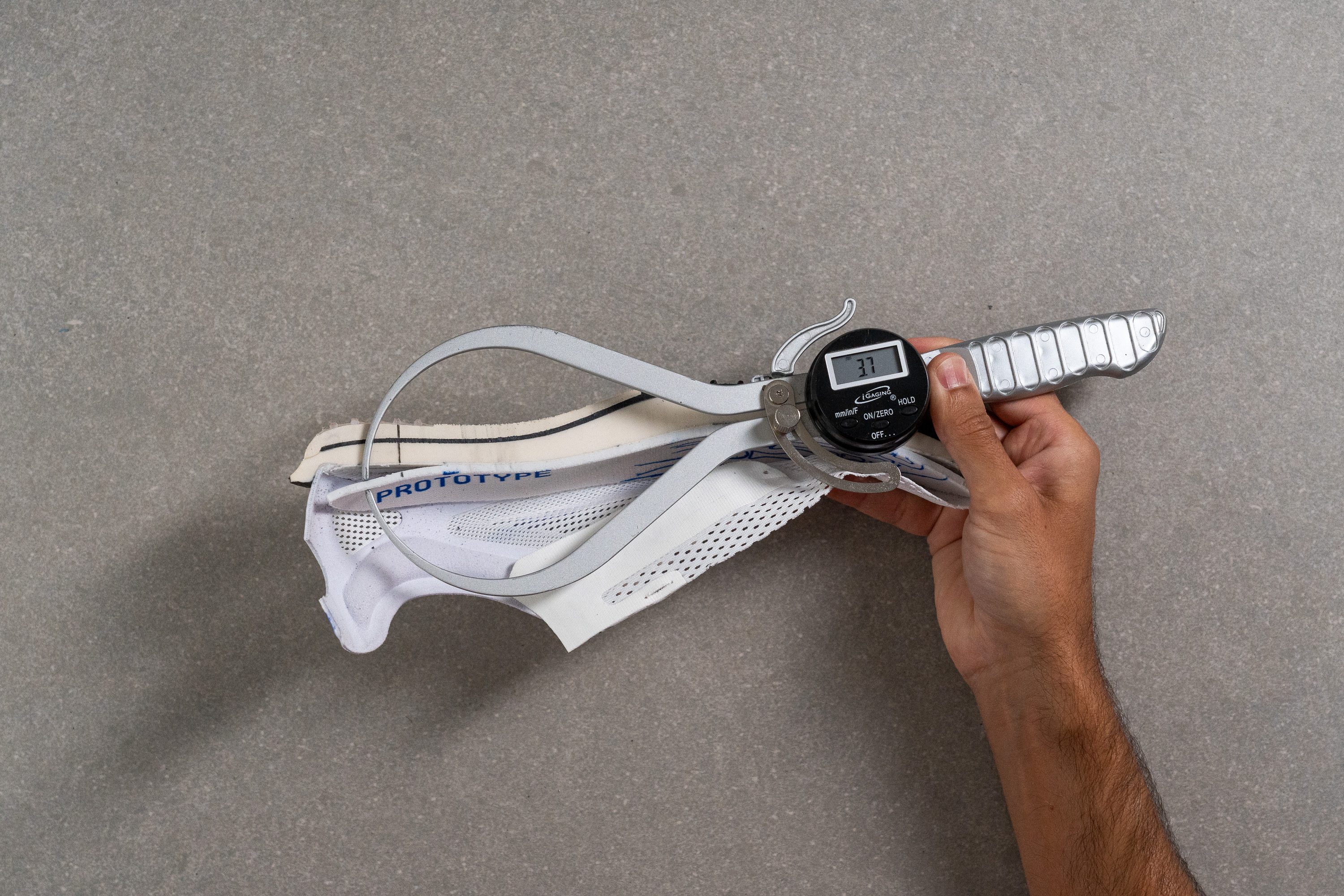
| Dragonfly 2 | 3.7 mm |
| Average | 2.9 mm |
Tongue padding
We discovered that Nike went all out to minimise weight, featuring an impressively thin 1.2 mm tongue. While it doesn’t offer a plush feel, it’s clear this design is laser-focused on racing performance.

The notched laces, which we’ve seen in other Nike road racers like the Alphafly 3 and Vaporfly 3, are as fantastic as ever—ensuring a secure fit.
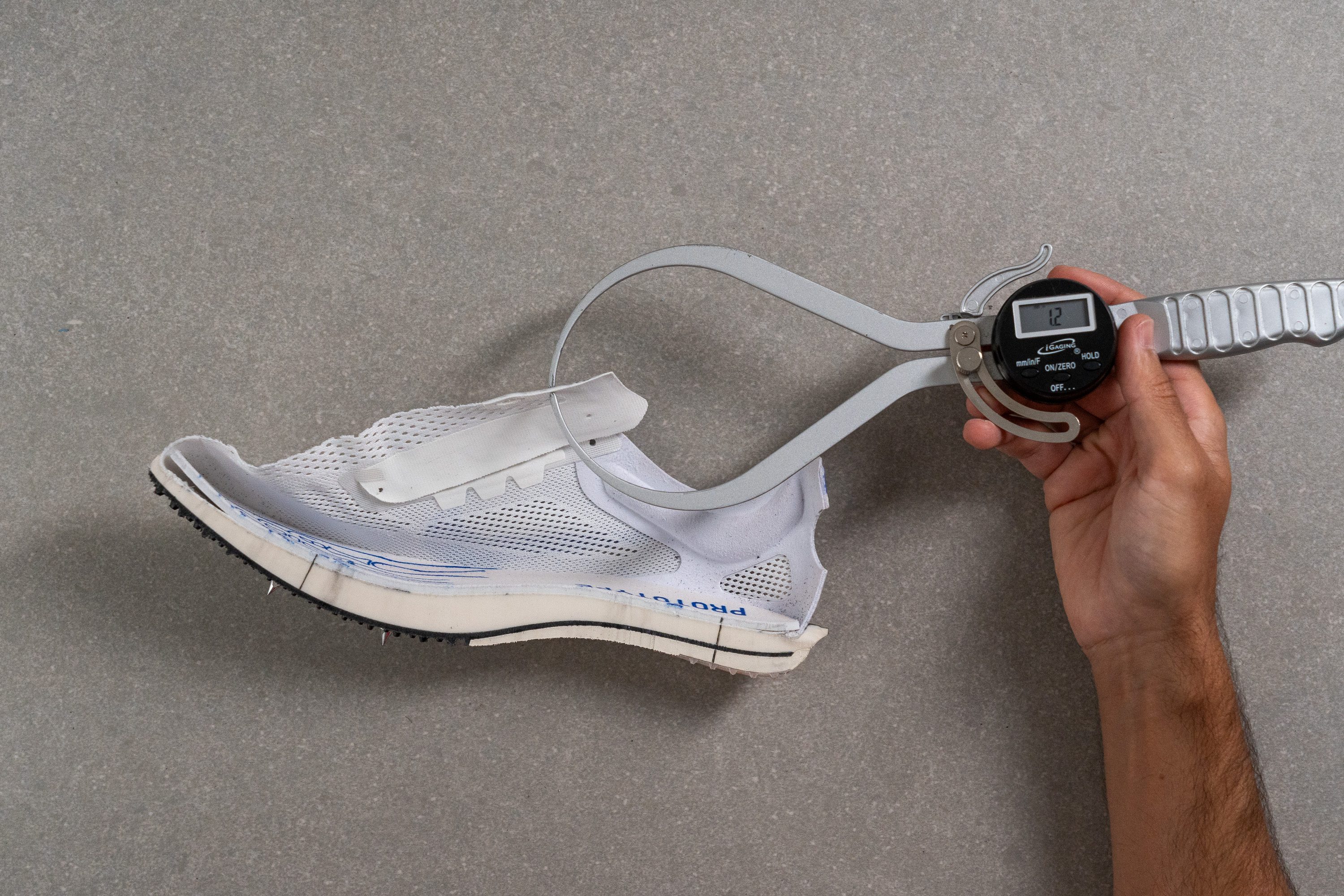
| Dragonfly 2 | 1.2 mm |
| Average | 2.3 mm |
Heel tab
The Dragonfly 2 retains the distinctive hole in the heel, which we found serves to reduce pressure in the heel area, improve the lockdown, and decrease the shoe's overall weight.

| Dragonfly 2 | None |

